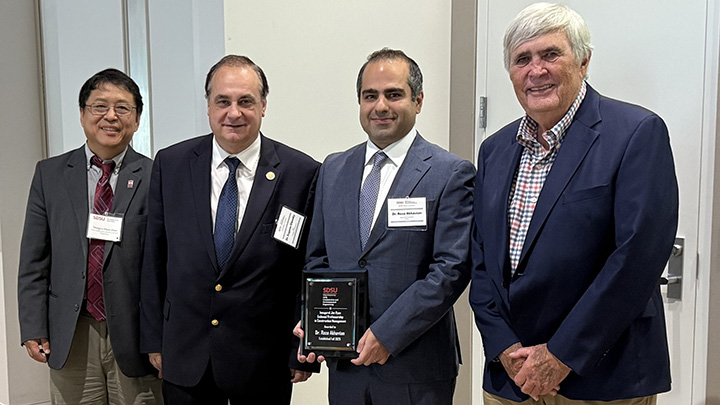If I had a Hammer
Tools for a new era in construction

It was a simpler time. A time when Americans could work their way to the top through hard, honest labor. A time when the country’s work force joined together to climb back from a decade of depression.
Musicians Peter Seeger and Lee Hays captured that national moment of hope and resilience in a single song. “If I had a Hammer” celebrated a post-Depression America ascending to renewed prosperity on the concrete arches of its bridges and the steel frames of its mighty skyscrapers.
Echoes of that enduring folk anthem still ring true today amid the worst economic downturn since the 1930s. In San Diego, the construction industry in particular is still reeling. Since a 2006 peak of 100,000 workers, regional employment in the industry has dropped by about a third.
But today’s construction managers need more than a hammer to repair the problems presented by a new century.
Even as the housing market slowly recovers, construction engineering professionals face a host of other challenges. They must manage a diverse labor force; understand the complex physical and structural demands placed on buildings; and stay abreast of the morphing policies, codes, guidelines and logistics that govern the industry.
In short, not only do the buildings have to be “smart,” but also the builders.
In San Diego, where construction is the fifth largest industry, some of the biggest names in the business have collaborated to increase the pool of young professionals who will guide the region’s construction industry into the future.
Their commitment helped establish the J.R. Filanc Construction Engineering and Management (CEM) program, one of San Diego State University’s newest and most successful degree programs.
The brainchild of Pete Filanc, former CEO of J.R. Filanc Construction, and Janusz Supernak, chair of SDSU’s civil and environmental engineering department, CEM addresses the acute shortfall of qualified and competent engineers who also possess advanced construction and project-management skills.
The program was established in 2005 with major gifts from Jack and Jane Filanc, ROEL Construction and other members of the Association of General Contractors (AGC), San Diego chapter.
To run it, SDSU recruited Ken Walsh, a professional engineer and former professor at Arizona State University, who holds the AGC-Paul S. Roel Chair of Construction Engineering.
Concrete solutions
While architecture and civil engineering are the traditional academic paths to a career in construction, today’s professionals need further skills in advanced construction and project management. The industry’s ability to improve and innovate depends on a workforce that can bridge the gap between practical experience and theoretical expertise.
“It’s one thing to know the properties of concrete, and quite another to know how to deal with the issues that arise when you start to pour it,” said Steve Doyle, an engineering alumnus and president of Brookfield Homes’ San Diego/Riverside division.
At SDSU, Walsh and his colleagues teach students to build bridges, literally and figuratively. Bridges that link people and ideas, theory and practice, academics and industry—for an economy whose needs are vast.
“Nationwide, the construction industry is two million workers and 200,000 managers behind demand,” Walsh said. “The problem going forward is that there is a shortage of built resources, and construction isn’t something you can outsource to India. Our hope is that CEM’s graduates will lead the industry as it meets the infrastructure development and maintenance needs of the region, the state and the country.”
The combination of engineering and management skills that makes CEM’s curriculum unique among university programs also explains its appeal. The College of Engineering had hoped for an enrollment of 100 students in the program at the end of five years. Instead, there are 150 after only two years. Abraham Ramirez and Ana Sical are two of them.
“If you had asked me what construction was before this class, I would have said ‘building,’” Sical said. “But now I realize it’s so much more. Construction is an expression of culture. Not only did I learn how the Egyptians designed and built the pyramids, but also why.”
New faces, new ideas
As the first in their families to go to college, Sical and Ramirez represent the changing face of construction management. The industry’s workforce has always been multi-lingual and multi-ethnic, yet management remains largely English-speaking, white and male. Walsh said the need for new leadership is clear.
“How else can we connect with the vast pool of ideas and resources this population brings to our industry?” he asked. “They are the lifeblood of innovation.” This industry-wide focus on creating culturally sensitive managers who are able to engage with their workers has a practical side as well. As Walsh observed, managers need to understand their employees’ concerns and be able to address them.
In an attempt to foster diversity in management, AGC-SD partnered with SDSU to provide scholarships to promising, ethnically diverse high school students from the Kearny Mesa Construction Tech Academy, one of four magnet schools developed on the education model championed by Microsoft founder Bill Gates.
For Ramirez, an AGC scholarship recipient, this support has been life-changing.
“My parents are hard workers and we would have worked together to pay for college. But this scholarship from AGC means that I don’t have to rely on them. It makes their lives a little easier, and mine a lot easier. I can focus on my studies and my future, not my bank account.”
In addition to financial support, the CEM program gives students crucial networking know-how by connecting them with the industry through internships, field studies and industry-sponsored events.
Last year, SDSU’s AGC student chapter met local industry leaders, such as John Daly, president of Daly Construction and former president of AGC-SD; Kevin Elliot, president of ROEL Construction and the new AGC-SD chapter president; and Doug Barnhart, founder and former chairman of the board of Barnhart, Inc., who now serves as AGC national president.
“These people have donated valuable time,” noted College of Engineering Dean David Hayhurst. “They are some of the biggest names in San Diego construction, and yet they make time to engage with our students.”
Lean and green
Frequent interaction with industry leaders also gives SDSU students an inside track on new trends in construction engineering. Two of the latest are lean construction and green construction.
“Construction companies will be investing in personnel with expertise in these areas, and SDSU students are in a great position to be at the forefront of these trends,” said Walt Fegley, president of Reno Construction.
Lean construction is aimed at reducing waste and literally getting lean; not just trimming the fat, but transforming the business model.
In the past, an independent developer would hire several independent sub-contractors for a single job. Today, developers are turning to large general contractors to provide fully integrated design and building teams that manage and shepherd projects from concept to concrete.
At the same time, the industry is embracing sustainable building tools and strategies in response to consumer demand for buildings with U.S. Green Building Council’s Leadership in Energy and Environmental Design (LEED) certification. Managers and employees with LEED accreditation supply added value in a competitive industry.
“We’re re-tooling and re-schooling,” said Fegley, who will join several of Reno Construction’s top managers in earning LEED accreditations at SDSU and attending seminars on lean construction, led by CEM Professor Colin Milberg.
Many San Diego construction companies are using this time of respite to regroup and plan for the next big boom.With new standards, new tools and an influx of enthusiastic new managers, the construction engineering industry is hammering out a strategy to connect San Diego’s people to their environment more efficiently and artistically than ever before.



